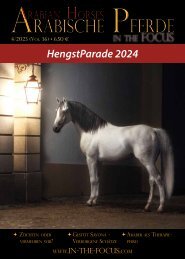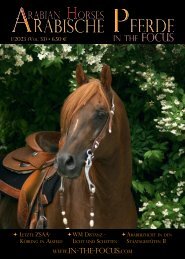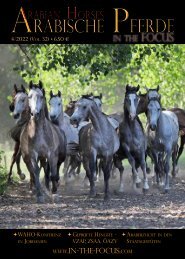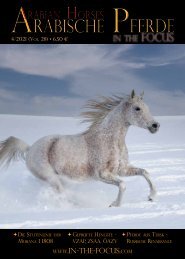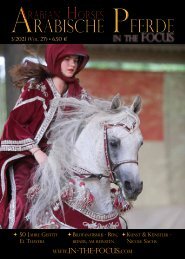Arabische Pferde IN THE FOCUS Nr. 2/2019 - Preview
Zeitschrift für Liebhaber arabischer Pferde
Zeitschrift für Liebhaber arabischer Pferde
Sie wollen auch ein ePaper? Erhöhen Sie die Reichweite Ihrer Titel.
YUMPU macht aus Druck-PDFs automatisch weboptimierte ePaper, die Google liebt.
Horses in the focus of science<br />
bone fatigue in Race<br />
and Endurance horses<br />
Science<br />
Horses breaking their leg during endurance competitions and races<br />
demonstrate the potential dangers of these sports.<br />
But these events should not be considered accidental or acceptable.<br />
Recent research including that from the<br />
Equine Limb Injury Prevention Program<br />
at The University of Melbourne has progressed<br />
our understanding of when, how and<br />
what kind of injuries occur in racing but a lot<br />
more work is needed to discover what trainers<br />
can do to reduce breakdown and deaths.<br />
Bone, like most materials, weakens when<br />
subjected to repeated high loads. Most bone<br />
and joint injuries in racehorses are the result<br />
of fatigue damage, which means they occur<br />
due to weakening of bone over the course<br />
of training and racing, rather than because<br />
of a single incidental injury such as a fall or<br />
trip. The bones of racehorses endure extreme<br />
loads repeatedly every time they gallop,<br />
with the highest loads occurring in the joints<br />
that are most commonly injured: the fetlock<br />
and knee (carpal joint). Thankfully complete<br />
fractures of bone occur infrequently, but less<br />
severe fatigue injuries to the joint surface are<br />
common in racehorses. Such injuries can result<br />
in poor performance and lameness but<br />
are hard to identify unless sophisticated imaging<br />
equipment like scintigraphy is used.<br />
The most important thing to understand<br />
about bone fatigue is that it builds up over<br />
time. Due to fatigue, tiny cracks will accumulate<br />
in the bone during training. This means<br />
that it is not what the horse was doing on the<br />
day an injury occurred that is most important,<br />
rather what the horse was doing in the days,<br />
weeks or months leading up to the injury. With<br />
every fast gallop or race, a proportion of the<br />
lifespan of the bone is used up. Training and<br />
racing intensely in the short term might seem<br />
to be a successful strategy if there is no immediate<br />
consequence, but by depleting the bone’s<br />
reserves it may have set the horse up for future<br />
injury. Bone injuries are most likely to occur<br />
in horses that do a lot of high speed distance<br />
work over the course of their career, or in horses<br />
that complete a very large amount of work<br />
in a short period of time.<br />
Managing Bone to prevent Injury<br />
Bone is an amazing tissue. It is not inert but<br />
highly dynamic and in the right training environment<br />
can adapt to increase its resistance<br />
to injury. Bone also has a repair mechanism<br />
that removes older fatigued bone and<br />
replaces it with fresh new bone. During training,<br />
the horse’s bone adapts to even short<br />
bursts of speed by laying down new bone to<br />
increase the total amount of bone (a process<br />
called modelling). Understanding and exploiting<br />
these processes is the secret to preventing<br />
injury.<br />
Bone adapts under Training Loads<br />
Most trainers know that a horse’s skeleton<br />
needs to get used to high speed exercise in<br />
order to reduce the risk of limb injuries, but<br />
accurate and sufficient information about<br />
the time it takes for bone to adapt to changes<br />
in exercise intensity throughout a racehorse’s<br />
training program is not yet available.<br />
New research from the Equine Limb Injury<br />
Prevention Program indicates that any horse<br />
rested from training for longer than about a<br />
week is at risk of injury from high speed work<br />
because of rapid bone loss or loss of adaptation.<br />
This means that any return to high speed<br />
training after such a rest should be gradual.<br />
Because it is time consuming, costly, and<br />
potentially unethical to assess the effect of<br />
different training loads on subchondral bone<br />
fatigue in racehorses, we are developing mathematical<br />
models to better understand this<br />
complex process.<br />
In one of our models we looked at the effects<br />
of gradually increasing or decreasing<br />
training load for three classes of racehorses:<br />
untrained two-year-olds, trained horses that<br />
had rested (spelled) for at least four weeks,<br />
and trained horses that are currently in training<br />
for more than four weeks.<br />
The model showed that for a young horse, at<br />
least 16 weeks of training is needed before<br />
bone has completely adapted to racing speeds<br />
– this is the case even for the most rapidly progressive<br />
training regimen. In practice, more<br />
time will be needed because training speeds<br />
must be increased slowly to avoid injury in a<br />
poorly adapted skeleton. There are no shortcuts.<br />
Complete adaptation might be several<br />
weeks less for racehorses that have undergone<br />
at least one full preparation.<br />
Typical fractures in racehorses include<br />
condylar fractures of the cannon bone above<br />
the fetlock. - Typische Knochenbrüche bei<br />
Rennpferden sind Frakturen des Röhrbeinknochens<br />
über dem Fesselgelenk.<br />
all images: Equine Limb Injury Prevention<br />
Program, The University of Melbourne<br />
On the other hand, bone loss (‘de-adaptation’)<br />
can be quite rapid when race training is<br />
interrupted. The model shows that even with<br />
short rest periods of ten days up to 10% of<br />
bone is lost, making it considerably weaker<br />
and therefore prone to injury if high speed<br />
exercise is reintroduced too quickly. Based<br />
on the model, such a loss would take 20 days<br />
to be recovered following the careful reintroduction<br />
of training and intense speed work<br />
62<br />
© ARABISCHE PFERDE - <strong>IN</strong> <strong>THE</strong> <strong>FOCUS</strong> 2/<strong>2019</strong>



